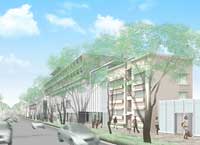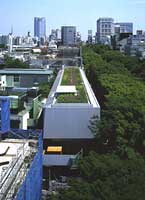|
|
|||||||
|
|
|||||||
|
|||||||
| | Web Japan >> | Trends in Japan >> | Lifestyle >> | Fashion Hub Gets a Facelift | |
|
FASHION HUB GETS A FACELIFT Ambitious Complexes Open in Trendy Omotesando (January 27, 2006) Omotesando, one of Tokyo's most cosmopolitan and trendy districts, is seeing a number of big changes this winter. Echika, a commercial development built inside the Omotesando subway station, opened on December 2, 2005. In February, meanwhile, the Omotesando Hills complex will be unveiled for all to see. These developments herald a new era for a district that has long been one of the most fashionable places in the capital. Underground Luxury Several of the 20 stores near the ticket gates offer quick services for customers in a hurry. For instance, there is a beauty salon that offers quick, inexpensive treatments priced at ¥2,000 ($18 at ¥115 to the dollar) for 20 minutes. Commuters looking for a place to eat can head to the food court, which has restaurants dishing up Vietnamese and Italian cuisine, as well as cakes and sweets. Six retail outlets are located within Echika's ticket gates, including a supermarket specializing in luxury food products. The total retail space inside the subway station covers some 1,300 square meters. Some of that was made available by converting the station's old offices, machinery rooms, and concourses. Echika's planners say they approached the project from the perspective of customers and commuters, with the aim of making the facility as beautiful, comfortable, and easy to use as possible. The renovations were extensive and included increasing the number of elevators and travel information centers as well as installing makeup counters in the women's restrooms. The final touches, including repairing the ceilings over the station platforms, are expected to be completed by March 2006. Echika's name is a contracted combination of the Japanese words eki, meaning station, and chika, meaning underground. The word also sounds similar to a phrase meaning "good underground." History in the Making Efforts are being made to integrate the mid-rise development with its elegant and fashionable surroundings. The complex is to feature a rooftop garden and reproductions of sections of the exterior walls of the Dojunkai Aoyama Apartments as part of its facade. In addition, the architects have strived to ensure that the new building does not obstruct the landscape by limiting its height to that of the famous zelkova trees that line the avenue. Another feature of Omotesando Hills is the sloping floors, angled at 3 degrees, roughly the same incline as the avenue. In the center of the complex is a vaulted ceiling six stories in height. Sideways Development This has prompted Tokyoites to ponder the future direction of urban development in the center of the capital. Will it be predominantly vertical or horizontal? Copyright (c) 2006 Web Japan. Edited by Japan Echo Inc. based on domestic Japanese news sources. Articles presented here are offered for reference purposes and do not necessarily represent the policy or views of the Japanese Government. |
CENTRAL TOKYO REBORN (June 19, 2003) GINZA, SHIBUYA GET NEW FACES (October 17, 2001) |
|
|





